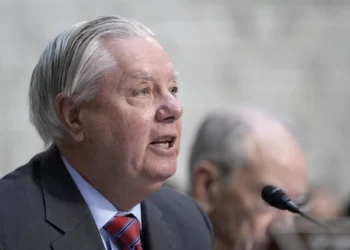WHAT’S HAPPENING TODAY: Good afternoon and happy Monday, readers! We hope you all had a restful weekend. We are taking a closer look at how the Treasury Department’s new guidance on the phase-out of tax credits will affect the wind and solar industries. Continue reading to see where Google plans to build its first small reactor.
Welcome to Daily on Energy, written by Washington Examiner energy and environment writers Callie Patteson (@CalliePatteson) and Maydeen Merino (@MaydeenMerino). Email cpatteson@washingtonexaminer dot com or mmerino@washingtonexaminer dot com for tips, suggestions, calendar items, and anything else. If a friend sent this to you and you’d like to sign up, click here. If signing up doesn’t work, shoot us an email, and we’ll add you to our list.
RENEWABLE INDUSTRY GROUP OPTIMISTIC PROJECTS CAN MOVE FORWARD UNDER NEW TREASURY GUIDANCE: Wind and solar projects do have some wiggle room to start construction and claim expiring subsidies despite the Trump administration’s efforts to stifle renewables, one industry group has said.
The details: Before the Treasury Department issued new guidance on enforcing the phase-out of the tax credits, developers had been able to claim the subsidies in two ways: hitting certain physical construction requirements or paying 5% or more of the total cost of the facility. While the new rules eliminate the 5% safe harbor for most projects, there is still a pathway – albeit a “subjective” pathway – for developers, Advanced Energy United’s Managing Director Harrison Godfrey told Callie.
“I still do see a wide variety of projects moving forward. I think particularly your smaller-scale projects, projects that are able to get off the ground relatively quickly and move into construction will be able to move forward,” Godfrey said.
Some have breathed a small sigh of relief that the Treasury did not crack down too hard, given other actions by the administration to curb renewables seen in recent weeks. Due to new restrictions imposed by the Interior Department, Godfrey said, projects that have more intersections with the federal government are more likely to face delays.
“I do think just given some of these dynamics, that makes it harder to see wind projects move forward than solar projects,” Godfrey said, warning that the amount of projects built will still shrink.
Other hurdles: The industry isn’t completely out of the woods yet, as project developers are still awaiting guidance around foreign entities of concern restrictions for the subsidies – which aim to restrict certain countries (like China) from benefiting from the credits. Godfrey told Callie that he expects new guidance will likely create additional hurdles for wind and solar developers, given these industries rely so heavily on foreign supply chains.
GOOGLE ANNOUNCES FIRST SMR PROJECT: A little less than a year after Google announced the world’s first corporate agreement to purchase nuclear energy through small modular reactors, the Big Tech giant has revealed where it will be building its first small reactor.
The details: Google and Kairos Power announced a new deal with the Tennessee Valley Authority (TVA) this morning, saying Kairos’ Hermes 2 Plant in Oak Ridge, Tennessee, will generate up to 50 megawatts of power. The energy will be pumped into the TVA’s grid, which powers multiple Google-owned data centers in Tennessee and Alabama.
The deal is the first time a major utility company in the U.S. has signed a power purchase agreement with an SMR facility. The Hermes 2 Plant is currently under construction and Kairos still has a number of regulatory requirements to complete including obtaining an operating license and having their SMR design approved.
Quick reminder: Last fall, Google inked a deal with Kairos to purchase upward of 500 megawatts of nuclear energy by 2035. The agreement called for the reactor to come online by 2030. The energy generated by the fleet of SMRs is expected to be used to power Google’s data centers and artificial intelligence advancements.
Read more from Callie here.
LEE ZELDIN BACKS FIGHT AGAINST NEW YORK BATTERY STORAGE PLANTS: The Trump administration has picked a new target within its broader war on renewable and green energy solutions, with Environmental Protection Agency administrator Lee Zeldin setting his sights on battery storage.
The details: Zeldin held a press conference on Long Island – in Hauppauge, specifically – today and issued his support for a group of residents who have been fighting against the construction of large battery energy storage facilities across the state.
Zeldin accused New York state officials of not taking safety concerns into account as they look to accelerate the installation of battery energy storage systems (BESS) in New York City and suburban areas. Last summer, state officials expanded their battery storage goals, ordering 6 gigawatts of storage to be installed by 2030.
Zeldin called the state’s goals “delusional,” and accused officials of working against their own “climate change agenda” because of the risks associated with BESS facilities, such as lithium battery fires. In a statement released after the conference, the EPA pointed to the May 2024 fire at the Gateway Energy Storage facility in San Diego, California, and the January 2025 Vistra Energy fire in Moss Landing, California. Both fires lasted for days. While lithium batteries can emit toxic hydrogen gases, experts have said these gases tend to dissipate rather quickly.
While Zeldin did not come out against BESS today, he did issue new guidance and protocols for states and local communities to consider all environmental risks associated with the facilities.
“We support local communities to have a say on whether or not they would like BESS facilities to be built in their neighborhoods,” Zeldin said. “At the very least, we want to provide all of the information we know on BESS to utilities, first responders, permitting bodies and any member of the public who wants to get better educated on this critical issue.”
WRIGHT SAYS DEMOCRATS SHOULD BE BLAMED FOR HIGH ELECTRICITY PRICES: Energy Secretary Chris Wright said that voters should blame Democrats for high electricity prices, but admitted that Republicans will bear the brunt of the fault.
Wright told Daily on Energy alum Josh Siegel, “The momentum of the Obama-Biden policies, for sure, that destruction is going to continue in the coming years.”
He added, “That momentum is pushing prices up right now. And who’s going to get blamed for it? We’re going to get blamed because we’re in office.”
According to the Bureau of Labor Statistics’ Consumer Price Index, electricity prices increased by 5.5% for the year ending in July.
The energy secretary also said that the administration is not seeking to “end renewables” and expects solar energy to continue to grow. The administration in the One Big Beautiful Bill Act ended tax credits meant to help wind and solar energy grow. The Treasury Department last week placed stricter restrictions for the phase-out of wind and solar tax credits.
“Within the administration, there’s dialogues about, how do we handle this?” Wright told Siegel. “People are mad about wind and they want to shut it down. There’s people, of course, that love it, and want more of it. But we got to balance those things.”
PETER NAVARRO CALLS FOR INDIA TO HALT RUSSIAN OIL IMPORTS: White House Senior Counselor for Trade and Manufacturing Peter Navarro is directly calling on India to end its purchases of Russian oil, the latest pressure from the Trump administration on India.
The details: In an op-ed published with the Financial Times this morning, Navarro accused India of directly fueling Russia’s war in Ukraine through its energy trade.
“As Russia continues to hammer Ukraine, helped by India’s financial support, American (and European) taxpayers are then forced to spend tens of billions more to help Ukraine’s defence,” Navarro wrote. “Meanwhile, India keeps slamming the door on American exports through high tariffs and trade barriers. More than 300,000 soldiers and civilians have been killed, while Nato’s eastern flank grows more exposed and the west foots the bill for India’s oil laundering.”
He called on India to slash its Russian energy purchases, indicating that the U.S. will not ease up on tariffs imposed earlier this month in response to the continued imports.
Oil prices began to tick back up on Monday on the heels of Navarro’s remarks, a clear indication that the global oil markets remain chained to ongoing diplomatic tensions. Just after 3 pm EST, both international and benchmark crude were up by around 1%. Brent Crude was priced at $66.56 per barrel and West Texas Intermediate was selling at $63.35 per barrel.
Rubio more conciliatory: While the administration’s criticism of India grows, direct pressure on Russia appears to wane. Over the weekend, Secretary of State Marco Rubio indicated that Washington was not poised to impose new sanctions against Russia as the president works to negotiate an end to the war in Ukraine.
“The moment the president puts those additional sanctions, that’s the end of the talks,” Rubio told CBS News on Sunday. “You’ve basically locked in at least another year to year and a half of war and death and destruction. We may unfortunately wind up there, but we don’t want to wind up there.”
EPA EXTENDS ADMINISTRATIVE LEAVE FOR STAFF: The Environmental Protection Agency extended administrative leave for employees who signed a dissent letter opposing the agency’s policies as damaging the EPA’s mission to protect human health and the environment.
Over 100 employees signed the June letter.
The staffers were placed on administrative leave as the EPA investigated the letter. The employees’ administrative leave was supposed to end in July, but was later extended to Aug. 15. Now, those same employees are experiencing yet another extension to their administrative leave.
“This email is to notify you that your temporary, non-duty, paid status [administrative leave] is being extended through August 29, 2025, pending the Agency’s inquiry into your signature on a declaration, to include potential use of EPA time and systems,” said the email, which was sent Friday to EPA employees who signed the dissent letter, E&E News reports.
HURRICANE ERIN: Hurricane Erin, a Category 4 storm in the Atlantic, is set to bring strong waves along the eastern coastline.
AccuWeather said the eye of the storm is expected to stay over the ocean. But, it could produce waves ranging from 5 to 10 feet to as much as 15 to 20 feet in areas such as North Carolina’s Outer Banks and Cape Cod, Massachusetts.
Hurricane Erin is forecast to follow a curved path between the East Coast and Bermuda this week. Tropical storm warnings have been issued for the Turks and Caicos Islands and the southeastern Bahamas.
Although the hurricane is not expected to hit land, the National Weather Service warned that strong rip currents produced by the storm could be life-threatening.
“A large portion of the Atlantic coastline will see the risk for high surf and rip currents increase this week due to #Erin,” NWS tweeted today.
“Life-threatening rip currents are likely. Swimming conditions are unsafe for all levels of swimmers. Stay out of the water. Always follow advice from the local beach patrol and flag warning systems,” it added.
A LOOK AHEAD:
Aug. 17 – 21 The American Chemical Society is hosting its Fall 2025 conference in Washington, D.C.
Aug. 18 President Donald Trump hosts Ukrainian President Volodymyr Zelenskyy and several European and NATO leaders at the White House amid the administration’s effort to end Russia’s war in Ukraine.
Aug. 19 The Alliance to Save Energy is holding its final session of its virtual summer policy series, focused on building the clean energy workforce.
Aug. 19 – 20 The Midcontinent Energy Summit is being held in Indianapolis, Indiana.
Aug. 20 The United States Energy Association is holding a virtual briefing on how data centers are “inexorably upending” utilities.
Aug. 21 HData is holding a webinar on the energy-related regulatory impacts of the One Big Beautiful Bill, featuring former Federal Energy Regulatory Commission Chairman Neil Chatterjee and former Texas Land Commissioner George P. Bush.
RUNDOWN
E&E News Trump team readies more attacks on mainstream climate science
Grist A startup promised 45,000 EV jobs to struggling towns. They’re still waiting.
CalMatters Gavin Newsom warms to Big Oil in climate reversal
















